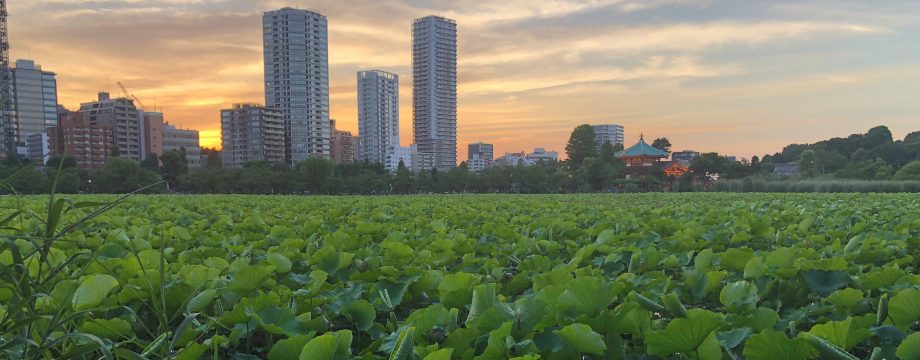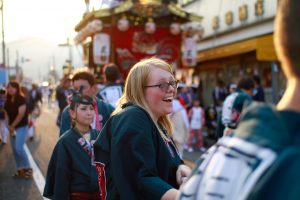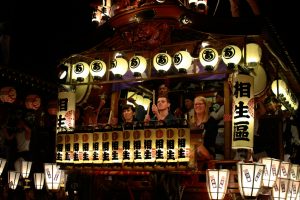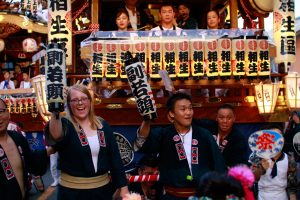The 14-15th was Onishi’s big Summer Festival, which is an annual music festival that brings together the 5 communities in town as they all perform taiko and haul a shrine around town. I was told going in that the festival included pulling the shrine in intense humidity all day only to stay up late at parties at night. But I was not prepared.
Naturally, this weekend had unusually hot weather for the area, with each day reaching 100 degrees with 80% humidity and no shade in sight. But that did not stop the giant shrine from being pulled at one of the hottest times of day, 2pm.
I went in with a basic understanding of what was going to happen: I was going to show up to the community center before two in my uniform so that I could help the shrine get out into the street as we take it on a predetermined route. Every time we pass another community center, there would be snacks or water waiting for us. That sounded like a pretty good deal to me.
I was able to wear one of the official uniform that was borrowed from a town member. And then we all got to tying out obi belts…even the Japanese staff members alone could not help the 13 of us clueless Westerners. Thankfully, a local woman Kiyomi walked in right that moment to gift us a tart she had baked. She was an obi expert, and was able to help us look official, at least for the first day.
All of the artists arrived at the community center at 2 and help pull the shrine out onto the street. It is on wheels, but people are already playing on it and it is very heavy. We went down a hill first, which was doable. And then we turned around and ascended the hill. This is where the pulling gets more intense, and the heat begins to hit me. I am not accustomed to heat like this, and if I have been somewhere hot, it was never this humid. Finally, we crest the hill to the next community center and are immediately gifted with water and ramune (soda)-flavored popsicles.
Next, a group of us move on to help with a kid’s shrine, which is a mini version of the shrine where no one plays, but it is decorated by the kids, so they too can pull something around town and feel useful. But, this year, one of the schools couldn’t make it and they asked the artists to help. We thought ‘aw, yay! Playing with kids!’. This was false, we essentially had the second float all to ourselves to pull around! It was quite a sight, a procession of the kids and foreigners floats.
Most of this time, I was going back and forth between helping and taking pictures, which meant I also had a camera around my neck. I thought we weren’t allowed to wear hats, but I was told to keep my water bottle and wallet in my back, held up by the obi belt. I was drinking water, yet I still felt faint. I found out very soon how important it was, especially when walking for hours in direct sunlight in the middle of the day, to take breaks. As soon as we broke for lunch, I took the coldest shower I could to take my body temperature down. Throughout the rest of the festival, I kept taking short 5-10 minute breaks when I needed to. Which at first, made me feel bad, because why do I need to take breaks when other people don’t? But it turned out to be a good idea, as there was one person who did faint and another who got heat exhaustion, and I did not want to be added to that list. The important thing was to listen to my body. Too hot? Yes, get some water or get IN some water! Find the 7-11 and stand in it for a couple minutes! This can help so much.
After the break for lunch, we met back up at 5 for the nighttime portion. With the sun setting, things got easier as the route got longer. Every time we approached a community center or a shrine, we would bow and clap to honor it. Then, around eight, all of the shrines gathered and faced each other. If shrines pass each other during the day on their routes, they may stop and ‘battle’, aka just play the best they can at each other and smile before moving on. At night, they all meet up for people to gather and watch. This is when myself and the artists get to get up on the shrine and play–thankfully not when it is moving!!
It was such a joy to play with Nathan and our coworker Kurumi. Before we knew it, we were tapped out and able to grab some festival food before bringing the shrine back to the community center for the night. Both nights of the festival, lunch and dinner were kindly provided by the community center, so we went afterwards to enjoy a platter of Japanese food and talk of a job well done.
But then, SUNDAY. And the festival ACTUALLY starts. For some reason, the festival officially starts at the opening ceremony around 4:30 on the Sunday. The Saturday and section before that on Sunday are…extra festival? I thought that was fake, but when the shrine came up to the crowd on Sunday night versus Saturday, there was barely room to move around, which was a striking difference.
Sunday was pretty similar to Saturday, with a few exceptions. We had a longer break ‘battling’ a shrine on Sunday, which allowed us to dance with fans to the ‘sore’ song, and some of us were invited up by the heads of our group to lead the dance with the lanterns! By going to practice every day, Nathan and I had built up a strong image with the leaders of the Aioicho taiko community. I think especially because they noticed our dedication, they let us do some special things like this that might usually be left out.
Also, when playing with the five shrines together at night on Sunday, the playing was met with fireworks!
Monday, we all got up to help clean, which went a lot faster with many people. And then we had the final party Monday night at the noodle shop, Tenguya. This was special because it is when the taiko leadership reflects on the things that went well this year and what can be improved, as well as electing new leadership. To be invited into this dinner/meeting was quite an honor. It became apparent how welcome we were when all of the bosses (Music head, Lantern dancing head, Children head, etc.) were going around, and my boss Kjell was announced as the Artist head.
The taiko practices in Japan are rooted in tradition. Some are falling apart, but in Onishi and many small towns, the traditions are alive and well. I am really thankful for Aioicho because it provided a unique space where 15 people who are not from the city can learn and play on the shrine in two weeks. Some other communities might make room for a couple, but for there to be unanimous room for everyone, even if they cannot play the entire pattern, was incredible. On top of that, the women in the community are so strong. At the final meeting, one of them gave a speech and said something along the lines of “thank you for supporting the loud-mouthed women even if we might say rude things to you sometimes”. Which, in a tradition that seems built mainly on the male lineage and parties that are very male heavy, is a breath of fresh air.
I am endlessly grateful for this opportunity and know I will always have a space at Aioicho should I choose to return.








